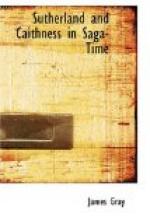find that Hakon had prepared a force to dispute his
rights. Hakon agreed, however, to give up his
claims to Magnus’ half share if Magnus should
obtain a grant of it from the Norwegian king.[12]
King Eystein about 1106 gave him this moiety and the
title of Jarl; and the two cousins lived in amity
for “many winters,” joining their forces
and fighting and killing Dufnjal,[13] who was one
degree further off than their first cousin, and killing
Thorbjorn at Burrafirth in Unst in Shetland “for
good cause.” Magnus then married, probably
about 1107, “a high-born lady, and the purest
maid of the noblest stock of Scotland’s chiefs,
living with her ten winters” as a maiden.
After “some winters” evil-minded men set
about spoiling the friendship of the jarls, and Hakon
again seized Magnus’ share; whereupon the latter
went to the court of Henry I of England, where he
appears to have charmed everyone, and to have spent
a year, probably 1111, in which Hakon seized all Orkney,
and also Caithness, which then included Sutherland,
and laid them under his rule with robbery and wantonness.
Leaving Caithness, Hakon at once went to attack Magnus
in Orkney where he had landed; but the “good
men” intervened, and an equal division of Orkney
and Shetland and Caithness was made between the jarls.
After some winters, however, they met in battle array
in Mainland, and the fight was again stopped by the
principal men on either side in their own interest,
the final settlement being postponed until a meeting,
which was to take place in Egilsay in the next spring,
Magnus arrived first at the meeting-place with the
small following of two ships agreed upon, but Hakon
came later in seven or eight ships with a great force,
and, after those present had refused to let both come
away alive, Magnus was treacherously murdered under
Hakon’s orders by Hakon’s cook on the 16th
of April 1116. The dead jarl’s mother,
Thora, had prepared a feast in Paplay to celebrate
the reconciliation of the two cousins, which, notwithstanding
the murder, Hakon attended. After the banquet
the bereaved mother begged her son’s corpse
for burial in holy ground, and obtained it from the
drunken earl after some difficulty and buried it in
Christ’s Kirk at Birsay. Twenty-one years
after, on the 13th December 1137, Jarl Magnus’
relics were brought[14] to St. Magnus’ Cathedral
at Kirkwall.
After making due allowance for the legends which generally
cluster round a saint or jarl, and grow with time,
and for the desire for dramatic contrast and effect,
we must give credit to the writer of the Orkneyinga
Saga, probably the Orkney Bishop Bjarni,[15] for
the vividness and simplicity of his account of St.
Magnus’ life and of the two most striking episodes
in it—his moral courage as a non-combatant
in the battle of Menai Straits, and his saintly forgiveness
of his murderers in his death-scene on Egilsay; and
we must hold him worthy alike of his aureole and of
the noble Norman cathedral afterwards erected in his
memory by his nephew, St. Ragnvald Jarl, at Kirkwall,
which took the place of Thorfinn’s church at
Birsay as the seat of the Orkney bishopric. Magnus,
it seems, was all through assisted by the Scottish
king, and favoured by the Caithness folk,[16] yet the
Saga jealously claims him as “the Isle-earl,"[17]
and adds the following description of him:—




